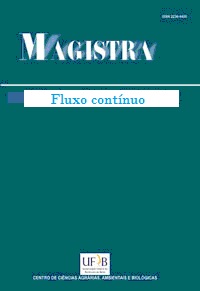Dormancy breaking methods for bird of paradise seeds
Abstract
Abstract: The bird of paradise is one of the most commercialized flowers in Brazil. The biggest difficulty in its seed propagation is the low germination percentage that occurs due to the physiological seed dormancy. It is necessary to study methods that can enable the commercial seedlings production from seeds, seeking efficient treatments to overcome dormancy. The aim of this research was the find the best treatment to break bird of paradise’s seed dormancy. It was tested methods of scarification with or without the addition of gibberellin, totaling six dormancy break treatments. The highest germination percentage for bird of paradise seeds is obtained using scarification with sandpaper in the micropyle region with 24 hours of imbibition with gibberellin.
Keywords: Physiological dormancy; Strelitzia reginae L., Gibberellin.
Downloads
References
Basavarajappa, H. R., et al. (2019). Genetic variability studies in Bird of Paradise (Strelitzia reginae L.). Acta Horticulturae, 1263, 47-54. DOI: 10.17660/actahortic.2019.1263.5
Foundation for Statistical Computing. (2019). Core Team : Language and Environment for Statistical Computing, (Version 3.5.2) [Software]. Vienna: Foundation for Statistical Computing.
Kantharaju, M., et al. (2008). Effect of antioxidant on in vitro establishment of Strelitzia reginae through shoot tip explants. Karnataka Journal of Agricultural Sciences, 21 (2), 324-325.
Kumar, S. S., et al. (2018). Effect of Growth regulators on seed germination of Bird of Paradise (Strelitzia reginae L.). Bulletin of Environment, Pharmacology and Life Sciences, 7 (supl. 1), 101-104.
Marcos-Filho, J. (2015). Fisiologia de sementes de plantas cultivadas (660p). Londrina: ABRATES.
Paiva, P. D. O., et al. (2004). Estabelecimento in vitro de estrelícia (Strelitzia reginae). Ciência e Agrotecnologia, 28 (5), 1031-1037. DOI: 10.1590/S1413-70542004000500009
Patel, D. K., et al. (2017). Effect of nitrogen and phosphorus on growth, flowering and yield of bird of paradise (Strelitzia reginae) under shade net. International Journal of Chemical Studies, 5, 1498-1500.
Ranal, M., & Santana, D.G. (2006). How and why to measure the germination process? Revista Brasileira de Botânica, 29 (1), 1-11. DOI: 10.1590/S0100-84042006000100002
Sane, A., et al. (2020). Growth, yield, physiological and biochemical traits of different accessions of bird of paradise (Strelitzia reginae L.). Industrial Crops & Products, 151 (3A), 112477. DOI: 10.1016/j.indcrop.2020.112477
Santos, A. A., et al. (2018). Characterization of genetic diversity of bird-of-paradise accessions. Ornamental Horticulture, 24 (1), 50-57. DOI: 10.14295/oh.v24i1.1132
Singh, A. K. (2006). Flower Crops: cultivation and management (46p). New Dehli: New India Publishing Agency.
Taiz, L., & Zeiger, E. (2017). Fisiologia Vegetal (6.ed., 888p) Porto Alegre: Artmed.
Van De Venter, H. A. (1978). Effect of various treatments on germination of dormant seeds of Strelitzia reginae Ait. Journal of South African Botany, Pretoria, 44, 103-110.
Zheng, S. X., et al. (2017). Initial study on 2n gametes induction of Strelitzia reginae. Acta Horticulturae, 1167, 157-162. DOI:10.17660/actahortic.2017.1167.24
Downloads
Published
How to Cite
Issue
Section
License
Autores que publicam nesta revista concordam com os seguintes termos:- Autores mantém os direitos autorais e concedem à revista o direito de primeira publicação, com o trabalho simultaneamente licenciado sob a Licença Creative Commons Attribution que permite o compartilhamento do trabalho com reconhecimento da autoria e publicação inicial nesta revista.
- Autores têm autorização para assumir contratos adicionais separadamente, para distribuição não-exclusiva da versão do trabalho publicada nesta revista (ex.: publicar em repositório institucional ou como capítulo de livro), com reconhecimento de autoria e publicação inicial nesta revista.








